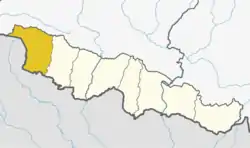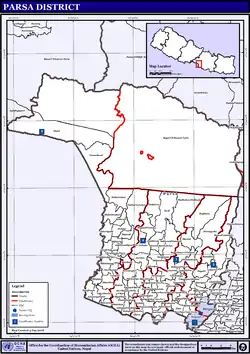Parsa District
पर्सा जिल्ला | |
|---|---|
 The gate in Birganj on the Indo-Nepal border | |
 Location of Parsa District (dark yellow) in Madhesh Province | |
| Country | |
| Province | Madhesh Province |
| Established | During Rana regime |
| Admin HQ. | Birgunj |
| Government | |
| • Type | Coordination committee |
| • Body | DCC, Parsa |
| • Head | Ajay sah sonar |
| • Deputy-Head | puran patel |
| • Parliamentary constituencies | 4 (List) |
| • Provincial constituencies | 8 |
| Area | |
| • Total | 1,353 km2 (522 sq mi) |
| Population (2021) | |
| • Total | 649,397 |
| • Density | 480/km2 (1,200/sq mi) |
| • Households | 95,516 |
| Demographics | |
| • Ethnic groups | Muslim, Kurmi, Tharu, Yadav |
| • Female ♀ | 48% |
| • Male ♂/100 female | 108.21 |
| Human Development Index | |
| • Income per capita (US dollars) | $1657 |
| • Poverty rate | 36.37 |
| • Literacy | 69.1% |
| • Life Expectancy | 70.25 |
| Time zone | UTC+05:45 (NPT) |
| Postal Codes | 44301... 44315 |
| Telephone Code | 051 |
| Main Language(s) | Bhojpuri (78.1%), Nepali (6.4%), Maithili (5.1%), Tharu (3.8%), Urdu (2.2%), others (4.4%) |
| Website | dccparsa |
Parsa District (Nepali: पर्सा जिल्लाⓘ), a part of Madhesh Province in Terai plain, is one of the seventy-seven districts of Nepal. The district, with Birgunj as its district headquarters, covers an area of 1,353 km2 (522 sq mi) and has a population (2001) of 497,219. According to the locals, Parsa is named after the Parashnath temple situated in Mahuwan.
Etymology
According to locals, the name of the district is derived from the Parsagadhi fort, where the Nepali Gorkhali Soldiers defeated British Soldiers.[3]
Geography and Climate
| Climate Zone[4] | Elevation Range | % of Area |
|---|---|---|
| Lower Tropical | below 300 meters (1,000 ft) | 74.7% |
| Upper Tropical | 300 to 1,000 meters 1,000 to 3,300 ft. |
25.3n% |
Demographics
| Historical population | |||||
|---|---|---|---|---|---|
| Census year | 1981 | 1991 | 2001 | 2011 | 2021 |
| Pop. | 284,338 | 372,524 | 497,219 | 601,017 | 649,397 |
| ±% p.a. | — | +2.74% | +2.93% | +1.91% | +0.78% |
| Source: Citypopulation[5] | |||||
At the time of the 2011 Nepal census, Parsa District had a population of 601,017.
As their first language, 78.4% spoke Bhojpuri, 6.1% Nepali, 5.1% Maithili, 3.8% Tharu, 2.2% Urdu, 1.3% Tamang, 0.8% Rajasthani, 0.7% Newari, 0.3% Uranw/Urau, 0.2% Hindi, 0.2% Rai, 0.1% Bengali, 0.1% Doteli, 0.1% Magar and 0.1% other languages.[6]
Ethnicity/caste: 14.5% were Musalman, 8.4% Kurmi, 7.6% Tharu, 6.6% Yadav, 5.8% Kanu, 4.7% Chamar/Harijan/Ram, 4.2% Teli, 3.2% Koiri/Kushwaha, 2.8% Chhetri, 2.7% Dusadh/Paswan/Pasi, 2.6% Hill Brahmin, 2.6% Mallaha, 2.0% Baraee, 1.9% Kalwar, 1.8% Dhanuk, 1.7% Nuniya, 1.7% Tamang, 1.6% Musahar, 1.6% Newar, 1.6% Sonar, 1.5% Bin, 1.4% Dhobi, 1.4% Hajam/Thakur, 1.4% Kathabaniyan, 1.3% Lohar, 1.3% Tatma/Tatwa, 1.2% other Terai, 1.0% Terai Brahmin, 1.0% Kayastha, 0.9% Marwadi, 0.8% Sanyasi/Dasnami, 0.7% Rajput, 0.6% Kewat, 0.6% Kumal, 0.6% Kumhar, 0.6% Magar, 0.4% Yakkha, 0.3% Dhunia, 0.3% Jhangad/Dhagar, 0.3% Kami, 0.2% Bengali, 0.2% Damai/Dholi, 0.2% Dom, 0.2% Halkhor, 0.2% Kahar, 0.2% Mali, 0.2% Rai, 0.1% Badhaee, 0.1% Gaderi/Bhedihar, 0.1% Gurung, 0.1% Halwai, 0.1% Majhi, 0.1% Natuwa, 0.1% Rajbhar, 0.1% Sarki, 0.1% Thakuri and 0.1% others.[7]
Religion: 83.1% were Hindu, 14.5% Muslim, 1.7% Buddhist, 0.4% Kirati, 0.1% Christian and 0.1% others.[8]
Literacy: 55.7% could read and write, 2.9% could only read and 41.3% could neither read nor write.[9]
Notable people
- Ajay Chaurasiya - Nepali Congress leader, former minister and former Member of House of Representatives/Constituent Assembly
- Ajay Kumar Dwivedi]] - Nepali Congress leader and Member of Constituent Assembly
- Bina Jaiswal - Bina Jaiswal is a Nepalese politician, belonging to the Rastriya Prajatantra Party. She is a member of Parliament currently serving as the member of the 2nd Federal Parliament of Nepal.
- Mohammad Lalbabu Raut Gaddhi - First Chief Minister of Madhesh Province
- Pradeep Yadav - leader of PSP-N and member of House of Representatives
- Arjun shah president Of [ District child club coordination network parsa ] Chief minister of [ Province Mock child parliament]
Administration
VDC/s and Municipalities (blue) in Parsa District The district consists of one metropolitan city, three urban municipalities and ten rural municipalities. These are as follows:
- Birgunj Metropolitan
- Bahudarmai Municipality
- Parsagadhi Municipality
- Pokhariya Municipality
- Bindabasini Rural Municipality
- Dhobini Rural Municipality
- Chhipaharmai Rural Municipality
- Jagarnathpur Rural Municipality
- Jirabhawani Rural Municipality
- Kalikamai Rural Municipality
- Pakaha Mainpur Rural Municipality
- Paterwa Sugauli Rural Municipality
- Sakhuwa Prasauni Rural Municipality
- Thori Rural Municipality
Former Village Development Committees (VDCs) and municipalities

References
- ↑ "NepalMap profile: Parsa".
- ↑ "Nepal Human Development report 2014".
- ↑ "नेपालीले अंग्रेजलाई हराएको पर्सागढी ओझेलमा". Online Khabar. Retrieved 2021-01-02.
- ↑ The Map of Potential Vegetation of Nepal - a forestry/agroecological/biodiversity classification system (PDF), Forest & Landscape Development and Environment Series 2-2005 and CFC-TIS Document Series No.110., 2005, ISBN 978-87-7903-210-1, retrieved Nov 22, 2013
- ↑ "NEPAL: Administrative Division". www.citypopulation.de.
- ↑ NepalMap Language
- ↑ NepalMap Caste
- ↑ NepalMap Religion
- ↑ NepalMap Literacy